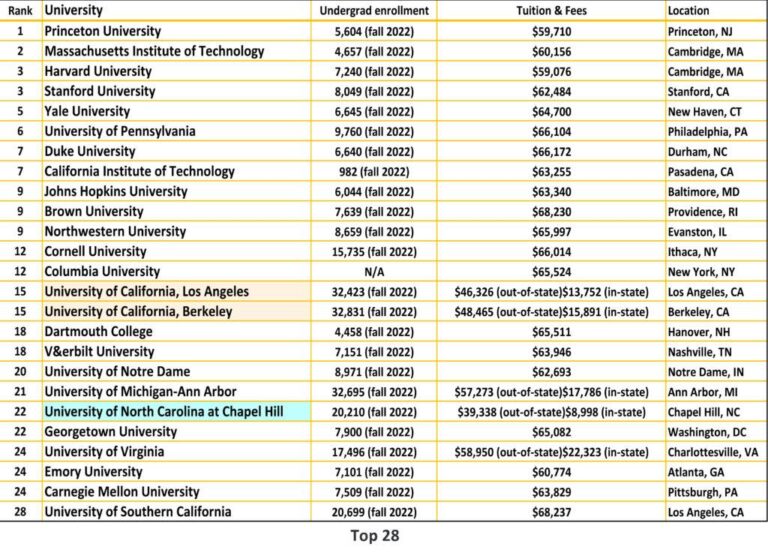The United States is witnessing a continued slide in its standing within the Times Higher Education (THE) World University Rankings, underscoring growing concerns about the global competitiveness of American higher education institutions. The latest rankings reveal a notable shift as several U.S. universities descend in position, reflecting challenges ranging from funding constraints to evolving international dynamics. This trend marks a significant development in the global academic landscape, prompting discussions among educators, policymakers, and stakeholders about the future trajectory of U.S. universities on the world stage.
U.S. Universities Face Growing Pressure in Global Rankings
U.S. universities have long been at the forefront of global higher education, but recent trends in the Times Higher Education (THE) World University Rankings reveal a mounting challenge. Several top institutions have witnessed a measurable slip in their standings, signaling intensified competition from emerging academic hubs abroad. Experts point to factors such as funding constraints, shifts in research output metrics, and growing investments by international counterparts as key drivers behind this downward trajectory.
The evolving landscape is further complicated by a set of new evaluation criteria, emphasizing international collaboration, citations per faculty, and industrial income. Universities outside the U.S. are capitalizing on these components, leveraging robust partnerships and innovative research initiatives. A snapshot of influential factors affecting U.S. rankings includes:
- Reduced federal research funding growth compared to previous decades
- Increasing emphasis on interdisciplinary and industry-linked projects worldwide
- Expanding presence and investment by Asian and European institutions
| Factor | Impact on U.S. Universities |
|---|---|
| Research Funding | Stagnant growth limits breakthrough projects |
| Global Partnerships | Lower compared to rising international competitors |
| Publication Citations | Decreased relative citation impact in recent years |
Analyzing Key Factors Behind the Decline in Performance
A deep dive into recent data reveals multiple intertwined factors contributing to the downturn in U.S. universities’ standings. Reduced federal funding has hampered research growth, limiting institutions’ ability to innovate and attract top-tier faculty. Additionally, there‚Äôs been a noticeable shift in the global landscape, with emerging universities in Asia and Europe making significant strides in technological research and international collaboration, putting further pressure on American counterparts. This competitive realignment is particularly critical as rankings heavily weigh metrics such as research output, citations, and international outlook.
Internal challenges also play a crucial role. Issues such as rising tuition costs have impacted enrollment patterns, especially among international students who often multiply a university’s global profile. Furthermore, administrative inefficiencies and slower adaptation to evolving pedagogical models have undermined the agility American institutions require in today‚Äôs dynamic academic environment. Key variables include:
- Decreased international collaboration opportunities
- Lagging investment in cutting-edge facilities
- Shifts in student demographic composition favoring domestic over international
- Stagnant or declining research publications in high-impact journals
| Factor | Impact Level | Universities Most Affected |
|---|---|---|
| Federal Research Funding Cuts | High | Large Public Universities |
| Decline in International Enrollment | Medium | Private Research Institutions |
| Global Competitor Advances | High | All U.S. Universities |
| Slow Curricular Innovation | Medium | Small Liberal Arts Colleges |
Impact on International Student Enrollment and Research Funding
The continued slide of U.S. institutions in the THE World University Rankings has exerted pressure on international student enrollment, a critical revenue source for many universities. With top-ranking positions increasingly occupied by global counterparts, prospective international students are exploring alternative destinations that promise greater prestige and opportunities. This trend risks shrinking the vital pool of tuition-dependent foreign students, affecting campuses nationwide and prompting urgent strategic shifts in recruitment and retention efforts.
Research funding is also feeling the ripple effects of these ranking changes. As global competition intensifies, funding agencies and private sponsors are gravitating towards institutions with rising reputations and innovative outputs. The U.S. faces the challenge of maintaining its research leadership amid these shifts, with some universities experiencing a decline in grant awards and partnerships. Key factors influencing this downturn include:
- Reduced visibility: Lower rankings correlate with diminished international exposure, impacting grants and collaboration opportunities.
- Competitive funding allocation: Agencies favor institutions that demonstrate high-impact research and rising academic profiles.
- Policy uncertainties: Shifting immigration and funding policies deter both talent mobility and external investments.
| Metric | U.S. Universities (2024) | Leading Global Peers |
|---|---|---|
| International Student Enrollment (% change YoY) | -4.3% | +6.7% |
| Research Funding Growth (past 3 years) | +2.1% | +8.5% |
| Collaborative Research Projects | 1,450 | 2,300+ |
Strategies for American Institutions to Regain Competitive Edge
To combat the ongoing slide in global academic standings, American universities must prioritize innovation in both teaching and research. Bolstering interdisciplinary collaboration can unlock novel solutions to complex societal challenges, attracting top-tier faculty and students worldwide. Additionally, increased investment in cutting-edge infrastructure and technology will enhance research capabilities and elevate the classroom experience. Institutions should also emphasize diversity and inclusion, recognizing that a vibrant academic community fuels creativity and broadens perspectives.
Strengthening partnerships with industry and international counterparts offers another pathway to regain prominence. By fostering practical, real-world applications of research, universities can enhance their reputation and secure new funding streams. The table below outlines key strategic focuses and their anticipated impact:
| Strategy | Expected Outcome |
|---|---|
| Interdisciplinary Programs | Higher innovation output |
| Infrastructure Upgrades | Enhanced research capacity |
| Diversity Initiatives | Broadened academic perspectives |
| Industry Partnerships | Increased funding & relevance |
| Global Collaboration | Stronger international profile |
Insights and Conclusions
As the U.S. continues to see its universities slip in the THE World University Rankings, questions persist about the underlying causes and the future trajectory of American higher education. With global competition intensifying and funding challenges mounting, stakeholders will be closely watching how institutions respond to maintain their historic leadership on the world stage. The decline serves as a critical wake-up call, underscoring the need for strategic investment and innovation to secure the U.S.’s place in the international academic arena.




